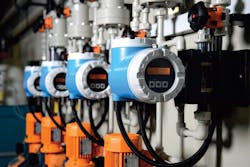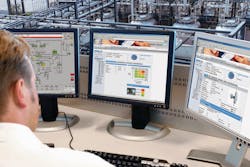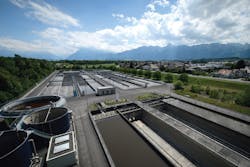In many process plants, instrumentation maintenance (see Figure 1) falls into one of two categories. The first is "too little, too late," where instrumentation fails because of a lack of preventive maintenance, often shutting down processes. The second category is "too much maintenance," where companies remove, calibrate, clean and service instrumentation that does not need it, at a high cost for parts, labor and equipment downtime.
Some instrument vendors offer capabilities and services to help end users manage maintenance through online diagnostics, asset management, proper scheduling of maintenance tasks and automatic alerts when problems come up.
This article describes how end users can exploit these technologies to simplify maintenance, lower costs, reduce parts inventories, and prevent unexpected equipment failures.
Instrumentation that diagnoses itself
Flowmeters and other process instruments have been available for years in "smart" versions, providing vital information for maintenance. For example, 4-20mA HART devices have been available since the 1980s. HART superimposes 35 to 40 digital parameters onto the 4-20mA signal, which can include device status, diagnostic alerts, configuration parameters and so on. Fieldbus instruments provide much of the same information through various protocols such as EtherNet/IP and Profibus PA.
Unfortunately, more than 60 percent of instruments are used only to measure the primary process variable, with the status and diagnostic data ignored by the control system. Maintenance technicians often have to access the data with handheld devices that plug into the flowmeter. A lack of understanding, training and useful software to process the data may account for maintenance departments not taking advantage of this capability.
Instrument suppliers recognized the problem and have gone to great lengths to equip flowmeters and other devices with on-board diagnostics, status information and other secondary device parameters that are needed by maintenance personnel — and they have provided the software needed to make all this data easily accessible and usable.
For example, flowmeters from Endress+Hauser are typically equipped with Heartbeat Technology, which provides a wealth of status and diagnostic information and performs vital functions such as condition monitoring and in-situ verification.
Condition monitoring recognizes if the measurement performance or the integrity of the flowmeter are impaired. The monitoring values are transmitted to an external condition monitoring system, which can be used to recognize trends in the secondary measured values and to evaluate relationships among individual parameters.
Legal requirements may call for flowmeters or other instruments to be calibrated periodically. This is normally carried out by removing the flowmeter from the process, taking it to a flow lab or calibration rig, and quantitatively comparing it to a traceable standard.
With modern instruments, the flowmeter’s transmitter electronics continuously run a qualitative assessment so all relevant components that influence the device function and integrity are checked. This confirms and can document by verification that no meter components have drifted outside original calibration tolerances. If the flowmeter calibration frequency can be extended, this represents tremendous savings in labor and process downtime.
More details can be found in the Flow Control article, "How flowmeters perform self-verification," published in April 2017.1
Maintenance management
Modern instrumentation provides status and diagnostic information, but processing all of this data is often a problem. For example, a chemical plant in Gendorf, Germany, has more than 4,000 instruments to measure level, flow, temperature, pressure and other parameters. Having its control systems read the diagnostic information from all 4,000 devices, analyze it for problems and issue instructions to the maintenance department would be a daunting problem for the plant’s control system programmers. It would also burden the control system with data irrelevant to its primary task, which is real-time process control.
Instead, instrument manufacturers developed software packages that perform all those functions. The packages fall into two basic categories: instrument management programs, which analyze real-time information from instrumentation; and asset management software, which keeps track of every instrument in the plant and stores vital data such as manuals and parts lists.
Figure 2. Asset management programs provide equipment manuals, parts lists and other information to handheld devices, such as Endress+Hauser’s Field Xpert SMT70.
Instrument management programs perform several functions to aid maintenance departments, including:
- Configuration — Helps maintenance configure new instrumentation during initial installation or when replacing an existing instrument.
- Condition monitoring — As noted above, used to analyze real-time data coming from instrumentation, look for problems and notify the maintenance department when a device needs attention prior to failure.
- Life cycle management — Tracks the entire life cycle of an instrument from initial configuration to calibrations and repairs, and provides information for audits and safety regulations.
While a particular instrument manufacturer can provide information for its own instruments, what about all the other instruments in a plant from different manufacturers? Fortunately, standardization across the instrumentation industry makes that information available.
Device Description (DD), enhanced device description language (EDDL), Device Type Manager (DTM), and HART and fieldbus configuration files are available from all manufacturers and can be accessed easily from various websites, then loaded into the instrument management program.
Asset management
When a plant has thousands of instruments, keeping track of manuals, parts lists, audit reports, maintenance schedules and other information can be a nightmare. A maintenance asset management program gathers all this information, digitizes it and makes it available to maintenance technicians via handheld devices (see Figure 2).
An asset management program typically provides:
- Instrument manuals — Modern manuals are available in digital form and are easily downloaded into the database while older, paper manuals can be scanned.
- Parts lists — Like manuals, parts lists can be downloaded or scanned.
- Compliance — The software tracks all instrument activities, including calibrations, verifications and maintenance performed to meet various industry and government regulations.
- Documentation and reports — The software can produce audits and regulatory reports that meet government and industry standards.
- Maintenance management — Determines when instruments need to be serviced, calibrated or verified, and notifies maintenance.
- Communications — The software can share data with other maintenance management programs, historians, spreadsheets, etc.
This information can be kept on-site or in the cloud, where it can be accessed from a workstation (see Figure 3) or a portable handheld device.
Figure 3. Instrument data from asset management software such as Endress+Hauser’s W@M program can be accessed from workstations or handheld devices.
Getting started
Many plants do not have sufficient information regarding their installed base of process instruments and analyzers, and over time the plants are modified and instruments change, worsening the situation.
One of the best ways to address this issue is by implementing a maintenance management program, often with the aid of a major instrument vendor. Most such vendors can come to a process plant, do an assessment of the instrumentation installed base, and make management recommendations on what needs to be done to improve the current situation.
For example, an Installed Base Analysis consists of:
- Instrument inventory — Find and list all on-site devices to enable further transparency, regardless of manufacturer.
- Assess device criticality and maintainability — Define and classify critical measuring points and its maintainability to ensure maintenance tasks can be performed easily and effectively.
- Recommend adequate maintenance strategy — Evaluate current maintenance activities and recommend improvements to achieve a
balanced maintenance program. - Identify obsolete equipment — Includes a migration plan to modernize the plant.
- Reduce complexity — Includes recommendations to standardize instrumentation and minimize spare parts.
At completion of the assessment, the instrument vendor will address its recommendations by providing key information to facilitate relevant decision-making regarding the maintenance and quality improvements, obsolescence and spares management of respective installed base assets. If the plant agrees, the project begins by implementing the new maintenance program within the scope of a service agreement. The data describing each instrument are entered into the database and maintained over time to enable the user to continually access up-to-date information at any time and from any location.
Figure 4. After an audit, the wastewater treatment plant in Switzerland installed Endress+Hauser’s W@M life cycle management software.
As noted earlier, the software may already have most of the data needed, such as DD and DTM files and manuals. In some cases, old manuals and parts lists may have to be found and scanned in. Eventually, the database will be populated.
A wastewater treatment plant in Thun, Switzerland, (see Figure 4) had an assessment conducted and then installed life cycle management software. Once data were recorded, a connection was established to the control system. The visualization program allows the plant to quickly identify a measuring device in need of attention. The necessary information can then be quickly accessed, including the right operating manuals, ordering information, maintenance reports, software drivers and spare parts.
The chemical plant mentioned also conducted an assessment and adopted such a program to maintain its 4,000 instruments. In the old days, documents such as calibration reports had to be scanned and filed manually. Today this information is available whenever and wherever it is needed. The plant can now identify each of its devices and react quickly in the event of a malfunction.
Summary
Modern instrumentation and related maintenance strategies make it much easier for process plants to perform preventive maintenance, eliminate process shutdowns from failed instruments, and save time and money by avoiding unnecessary maintenance activities.
Initial implementation of an instrumentation management system can be a daunting task, but instrument vendors can provide assistance as required.






